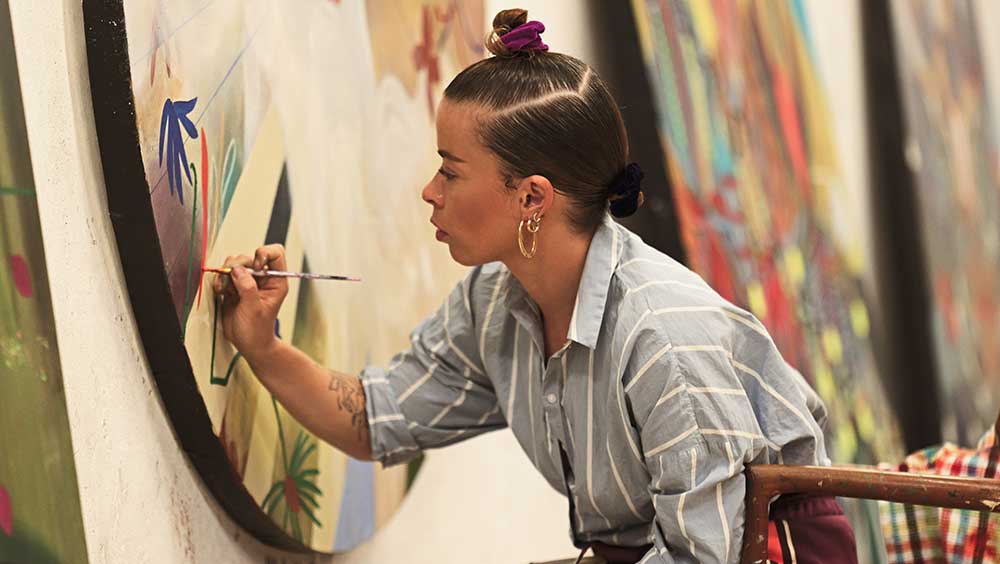
Tiffanie Delune. Photo: Abdel Abdulai, courtesy of the artist and Gallery 1957.
by ANNA McNAY
Tiffanie Delune (b1988, Paris) is a self-taught, mixed-media artist, whose richly vibrant canvases radiate movement and warmth. The recurrence of primordial forms, including circles, plant shapes, labyrinths and ladders, offers the viewer a springboard for entering the phantasmagorical world within the otherwise increasingly abstract compositions. It is apparent that these paintings want to tell stories, but it is up to the individual which lens to look through.
Delune explores and exploits her femininity in her work, describing some of her material choices as traditionally female. Certainly, additions such as glitter do seem to emphasise this, while also enhancing the magical and spiritual tone. Even in Delune’s early works, which drew heavily on her experience of trauma, she wanted the finished piece to look joyful. Her underlying messages, or lessons, were all the more powerful for this gentler, less shocking approach.
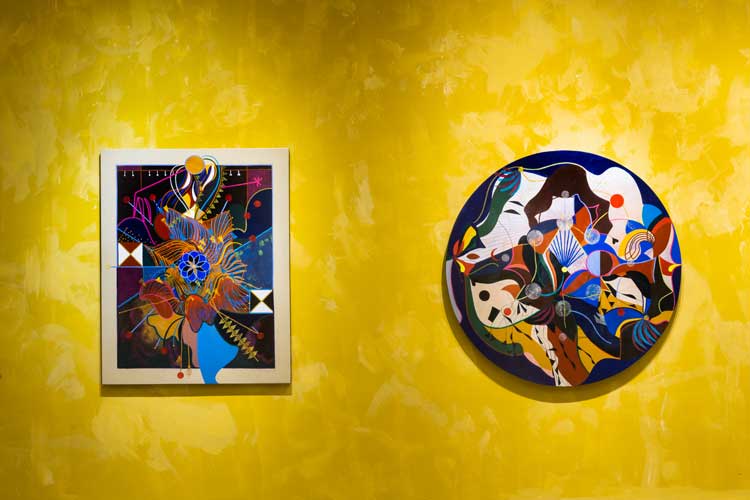
Tiffanie Delune: There's Gold on the Palms of My Hands, installation view, 2023. Courtesy of the artist and Gallery 1957.
Place greatly influences Delune and her work, in terms of culture and identity, as someone of French, Belgo-Congolese heritage, now living in Lisbon, as well as in terms of where she is at the time of creating the piece. The 15 new works in There’s Gold on the Palms of My Hands, at Gallery 1957, were all made on site during a three-month residency with the gallery, in Accra, Ghana, and Delune feels that her time there has helped her overcome her fear and avoidance of darker tones. Fittingly for an exhibition entitled There’s Gold on the Palms of my Hands, she also asked the gallery to paint its walls gold, which offsets the palette of the paintings splendidly.
In this Zoom interview for Studio International, during the final throes of installation, Delune talks about the residency, her dream life, her spirituality and how she keeps her energy flowing.
Anna McNay: Tell me a bit about your practice. What would you say are your key themes?
Tiffanie Delune: I am very interested in the world of dreams and magic, which is one of the reasons my work has been moving more and more towards abstraction. I used to have more bodies, or figures, in my compositions, but they have disappeared over time. The body of work in my exhibition here in Accra, for example, is strictly abstract, even though you will still find some recognisable elements – mainly creatures – here and there.
My starting point is the inner self and our journey through life, made up of both spiritual and physical experiences. My work is very into spirituality, magic and storytelling. I always, in some way, start off with myself and the lessons that I have learned, but I also understand that they are universal. I speak of myself, but I’m never self-centred. I think of it as sharing myself with the world so that we can all have a discussion about it. I like the idea of dreaming, too, because the world is quite depressing most of the time. I like my work to feel joyful, dreamy and magic, even if the lesson behind it is harsh. I don’t want the work to be traumatic or aggressive.
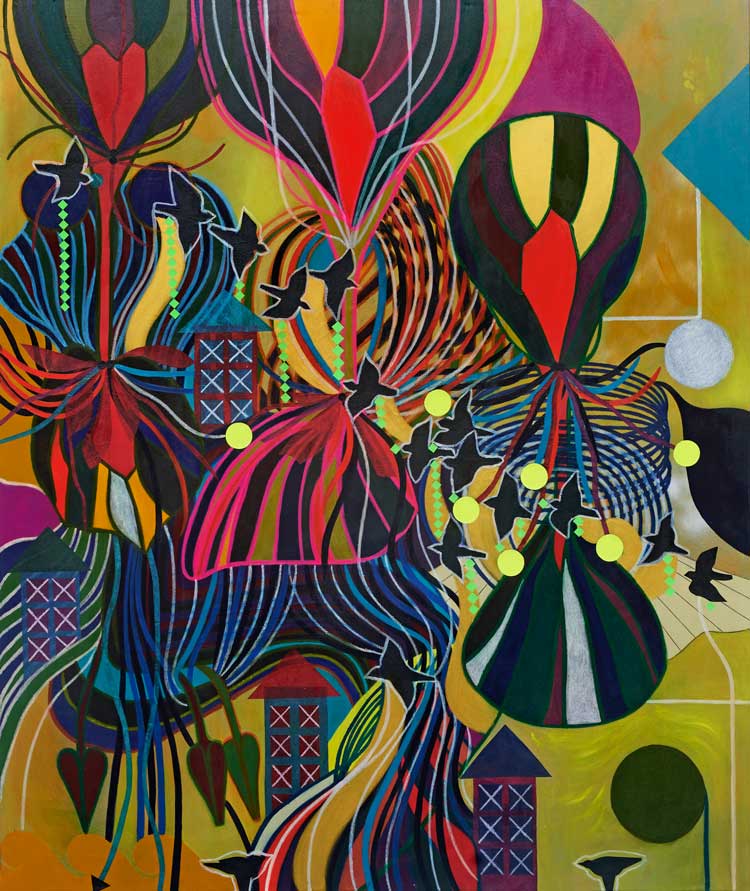
Tiffanie Delune, Everywhere is Foreign, Everywhere is Home, 2023. Mixed media on cotton canvas, 180 x 150 cm. Courtesy of the artist and Gallery 1957.
AMc: You talk about dreams, and some of your works have been described as dreamscapes. Are these dreams that you have had, would want to have, or are they purely imagined?
TD: It’s usually a mix of lived experiences, which might begin with a photograph, because I have taken photographs from a very young age, and fantasies, as I meditate a lot and practise hypnosis, so you never know whether something is the real thing, a fantasy, or your subconscious. Then, yes, there are apparitions from my dreams because, for example, if I’m working on something, and then I go to sleep, for sure I will have some sort of visions that will eventually complete the work. I will see shapes or colours. It’s hard to describe. Obviously, dreams are hard to explain anyhow, but because my imagination is engaged on a daily basis, my dreams are quite dynamic. Everything is a bit blurry and sits at the intersection of reality and fantasy.
AMc: You said that you don’t want the work to be traumatic or aggressive, even if the lesson is hard. Does your work always have a narrative or a lesson to it?
TD: My works always have deep meanings. When I first started making art, I used it as a cathartic process and was speaking a lot about my family and my childhood, which was quite harsh. I was using it as a form of a visual therapy. From the beginning, I knew that I wanted it to feel truthful. I always thought: “OK, this is what I want to say, and this is the message, but how do I make it joyful, playful or unexpected?” I think that’s where the abstraction came more and more into play. And, yes, it always has a lesson. Even though I have moved away from these very specific autobiographical stories, I usually have something I want to say, and I ask myself how best to do this. But it can sometimes happen the other way round, as well. I show up every day, even if I don’t consciously have something to say, and sometimes it just starts to flow, and, as it does, I come to understand what it is I want to say. The story can be the starting point, or the story can come through the process. When this happens, I believe it is my subconscious guiding me. I call it a dialogue with the work.
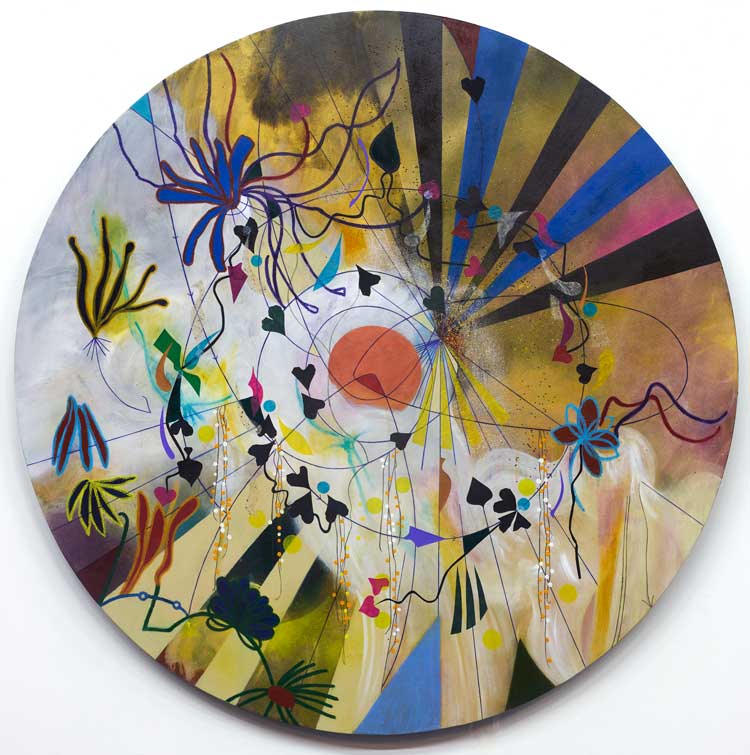
Tiffanie Delune, Healing Is A Dance With The Stars, 2023. Mixed media on cotton canvas, 150 cm. Courtesy of the artist and Gallery 1957.
AMc: How important is it to you that the viewer understands the meaning and lesson you have in mind, or can they find their own interpretation of your work?
TD: It’s not that important whether they understand it or not. When I make a work, I do it mainly for myself. The most important thing for me is that the work should engage your imagination and playfulness. Figurative works sometimes do not do this as much, because you are directly representing something. This is part of the reason why my work is becoming more abstract. I don’t want to dictate what it should mean to someone else. It doesn’t matter to me whether you understand it the way I meant it. It’s quite magic because I get told so many different stories of people seeing so many different things and referring to places that I’ve sometimes not even been to or to films that I’ve never watched. I’m liberated, because I have said what I wanted to say, and now it’s up to you how you want to take it.
AMc: How important is the idea of the feminine in your work, and do you think it is recognisably by a female artist, or is that irrelevant to you?
TD: I think you can see that I’m a female artist. You can probably see it in my use of colour, first of all. This might be a cliche, but most of the time men use more primary colours or blend a little bit less. The way I blend colours, and the fact that I sometimes use richer or deeper colours, is quite a feminine approach. Also, I use glitter. I use threads, I use paper cuts, and I work on textile, all of which are typically categorised as women’s crafts.
I think my shapes are quite feminine, as well. Because my work is so into spirituality, I’m very interested in the natural world, so a lot of my shapes become very organic. I’m also interested in anatomy, so other shapes might be some sort of body parts. This is feminine energy. Nature, spirituality and body parts are all the same.
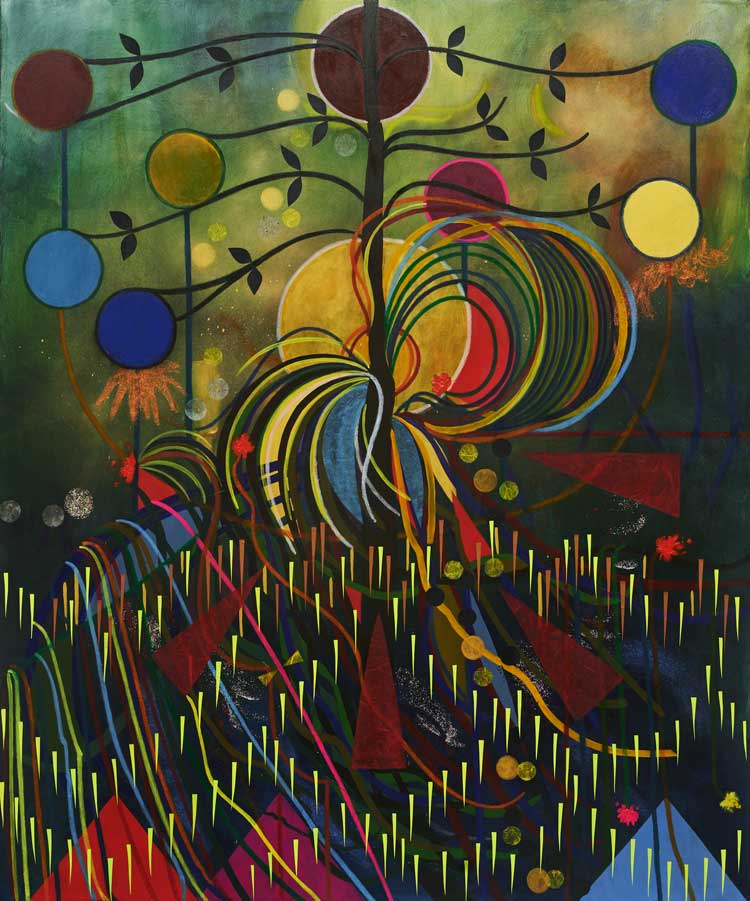
Tiffanie Delune, No Longer Afraid Of The Dark, 2023. Mixed media on cotton canvas, 180 x 150 cm. Courtesy of the artist and Gallery 1957.
AMc: Would you say that you have built up a lexicon of forms or motifs, which recur in different works?
TD: Exactly that. The circle is very present in my work. It is a symbol of fullness, of the cycle of time and also of the belly and pregnancy. It’s the moon, it’s the sun. This symbol represents so many things, and I love exploring all the ways you can use it. Then you have birds coming into my work a lot. Because I am becoming more abstract, they might have different appearances, but they will be birds. My paper cuts start from triangles, squares and diamond shapes, and go on to flowers. These can become very mystical, as well. If you look at my work, you will see these shapes reappearing. I think I started with non-shapes, and I kept on creating my own over time. I have started documenting my shapes, creating a sort of dictionary, as you say. It’s sometimes nice to have this visual reference when working, and it also ensures that the works stay consistent and coherent.
AMc: You have mentioned quite a lot of the different materials you use. Do you have a preferred medium, or is your practice more experimental in terms of putting things together?
TD: It used to be very experimental, but now my process is more informed. When I first started out, I only used acrylic paints, but I quickly found them to be quite flat and unable to express everything I wanted to express. I started adding oil pastels for their texture, mainly, but also their colours. Then paper cuts started coming into play, and, with these, you can have different textures of paper as well, which opens up a very fascinating world. Gradually, I added more simple things, such as the glitter and the threads. I don’t use them all the time, though. The thread, for example, has to be relevant to what I’m saying. I think pastels and paper cuts will always be there, but the glitter, the threads and the pens, inks and pencils – all the small details – depend on the work and its scale. Obviously, if the work is very big, certain things will not be as necessary as they would for a smaller work. The way I look at the material is about the texture and the colour but also the memory of it and what it evokes, so it has to be relevant to the work itself. I wouldn’t do something for the sake of it.
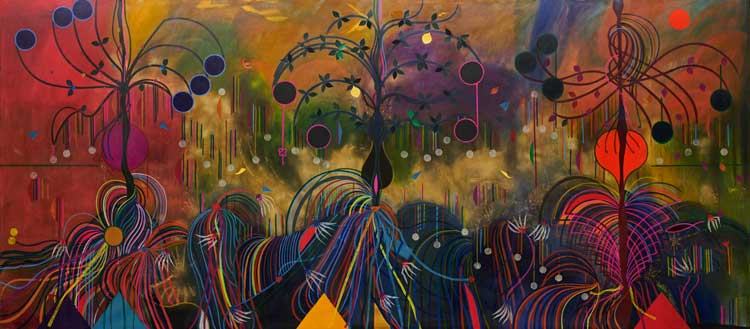
Tiffanie Delune, The Fall Is Never Too High To Blossom, 2023. Mixed media on cotton canvas, 450 x 200 cm. Courtesy of the artist and Gallery 1957.
AMc: You mentioned scale. What range do you work across?
TD: The biggest work for this exhibition is 4 metres by 15 metres. It’s my largest to date, and it’s definitely more of a museum piece. I was encouraged by the gallery here to work large scale if I wanted to, because the studio is very big. I also work on paper as small as a regular piece of A4. I enjoy this very much because, with the work being so much smaller, you have to be very detailed and very slow and very soft in your approach, and it has an intimate feeling. I always say that I love the dialogue between the scale and the subject because, on such a small piece of paper, you’re having a very intimate moment with the work. I want every little detail to be perfect, whereas, for a large-scale piece, I feel that the scale already speaks for itself. You still delve into the detail, but the process is different.
AMc: Do you work straight on to the canvas, or do you sketch something out in advance?
TD: It’s very rare that I sketch out a full piece beforehand. I don’t think it’s fully possible. I might have some ideas that I will roughly sketch. For example, I have a work with three different trees in it, which grew out of a smaller one with just the one tree. I really enjoyed making that tree, and so I thought: “Why don’t I do another one with three trees from the different seasons, not including winter?” In that instance, I had the idea in my head, and to quickly see how it would look, I made a sketch on a piece of paper, but then I let most of the work and the dialogue happen on the canvas.
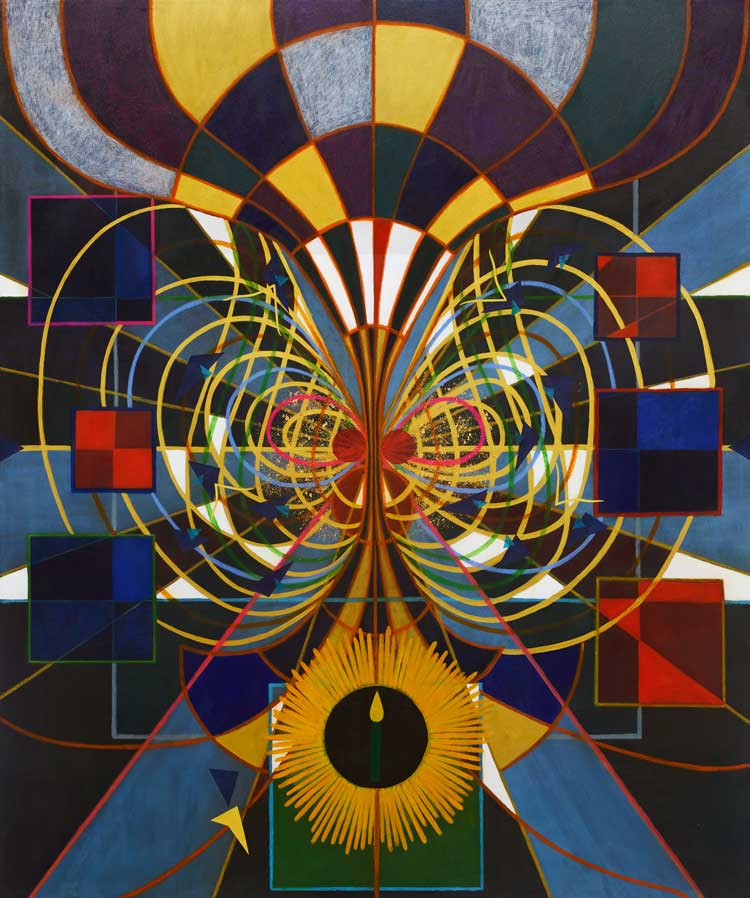
Tiffanie Delune, Rooted In Motion, 2023. Mixed media on cotton canvas, 180 x 150 cm. Courtesy of the artist and Gallery 1957.
Sometimes, as I said before, I might have some sort of vision, and I will sketch that, but that doesn’t mean that will be how the finished piece looks. It could become one element of the piece. It could also be the starting point, which will then evolve when I begin working. It could even be something that I want to do, but which I’m not ready to do, and then maybe I’ll come back to it later.
AMc: Do you have any rules that you follow when you’re creating a composition, or is it completely led by instinct and intuition?
TD: The first thing I do, and this will always be the case, is I layer the background, because I don’t want it to seem like a background. I want it to be as prominent as the foreground. Starting with that, and creating a spiritual feel, with lots of movement and variation of colours, and some elements of light, darkness and shadow, is very important. That gives me the “spine” of the work, and the spirit. Then I allow myself to flow on to the canvas. The colour depends on where I am – physically speaking, but also in terms of my head space – and also on the season. I tend to do darker work in the winter and brighter work in the summer. But it can also be influenced by my moods, my emotions and what I’m going through at the time. I usually like working on two or three things at the same time, so one work will be at the background, starting stage, another will be more advanced, and maybe the third will just need a final touch. This allows me not to rush my work, or to try to do it all at once, because one work can feed into another.
AMc: Might you work on more than one piece on the same day, even?
TD: Yes, I might switch. Today, I have one that I just started doing the background on, and I have one on the floor that I’m finishing up. I know exactly what is going to happen with the one on the floor, because it’s pretty close to being finished. It’s just the small bits, the details, that need adding, but they usually take more time because you really don’t want to mess up. When you’re at the beginning, you’re flaring and flowing and it’s much more energetic. I like the mix of these two moods. Also, in the morning, I usually like to do thorough, quiet and meditative work, whereas, in the afternoon, to keep my energy flowing, I will do the more physical side of things. The mix of the two allows me to remain productive rather than sitting and staring at the work.
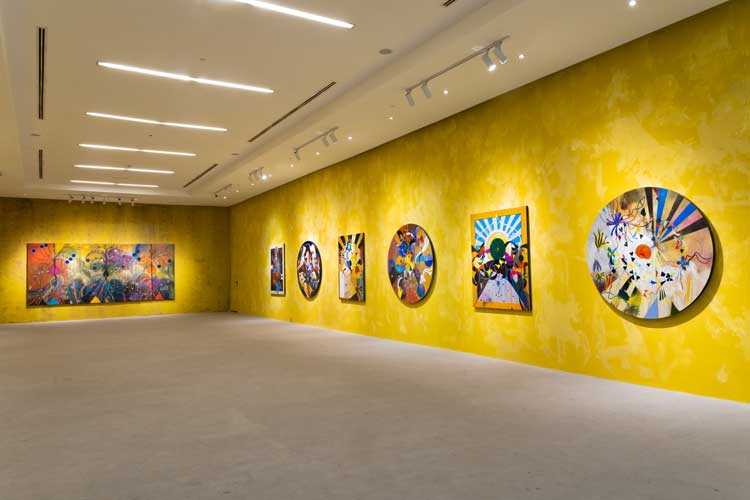
Tiffanie Delune: There's Gold on the Palms of My Hands, installation view, 2023. Courtesy of the artist and Gallery 1957.
AMc: Tell me about your titles. Where do they come from and at what point?
TD: Titles are very important to me. They are absolutely part of the work. I have always loved poetry, so words mean a lot to me, not to the point where I would become a writer, but they really complete a work. I can’t ever see myself calling anything Untitled. I have some titles that come to my mind without my even having done any work. I randomly think: “Oh, that’s such a good title,” or “That’s such a playful combination of words”. Sometimes I can think of a visual way of expressing that title right away, but sometimes I need to take a note of it, keep it aside and come back to it later. Other times, I start a work, and I have no idea, as I say, of exactly what’s going to happen. So, I don’t have a title either. With abstraction, I think you sometimes have to let it happen, and, a few days later, you start to understand what you have done, and what was being communicated to you, and then you will find a title. For example, I had the title of this show – There’s Gold on the Palms of My Hands – in my head for six months, but I never knew it would be the title of this show. I remember thinking that I liked it. I was waiting for the right opportunity for it. I thought it was too strong for just one piece, though, so I decided to use it for this whole show.
AMc: Tell me some more about the show. Does it have a particular theme or focus?
TD: Well, it’s my first fully abstract show. I have 12 canvases, and I will have three hanging textiles, hanging in the venue, not on the wall, because I’m not just questioning scale, I’m also questioning how you experience the work. I’m keen to move away from constantly staring at a wall.
The other thing is that the walls won’t be white. I asked the gallery to paint them gold. I want people to feel they’re walking into a complete universe, not a room full of individual works. I like the idea that you remember a show and not just a mass of works. I’m quite excited because my colours have been evolving a lot here in Ghana. I used to be a bit afraid of dark colours, but I have finally managed to find a balance between bright and rich colours and darker tones. I have also been more focused in my approach, so one work says just one thing, rather than too many things at the same time.
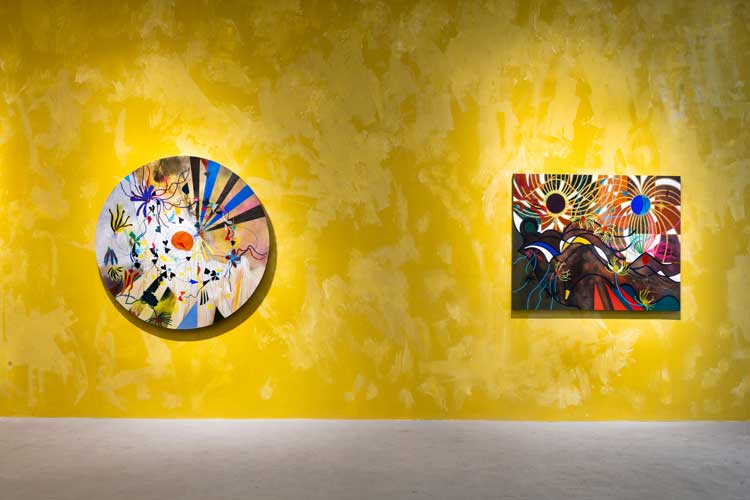
Tiffanie Delune: There's Gold on the Palms of My Hands, installation view, 2023. Courtesy of the artist and Gallery 1957.
AMc: Do you think you will take those colours with you, or does it very much depend on place and, as you said, season and mood?
TD: I will certainly take with me this darkness I used to avoid. I mean, sometimes I think I was avoiding it, and sometimes I would try and fail. I finally feel like I know how to do this. Another thing I came to understand here is that you can be intense and joyful at the same time. As I said, what I’m trying to avoid are any negative or aggressive feelings, and I think I finally managed this. Yes, it’s intense, but it’s joyful, and it’s colourful, and it’s dreamy. Part of dreaming is that you sometimes have nightmares, so it’s normal to have moments that are more intense, works that are a bit more intense than others. Some of the works are very soft, and some are a little bit more direct, but that’s not necessarily a bad thing. I think it’s part of me growing as a woman and being more confident with that; being more confident with intensity and energy. This is just how it is.
AMc: Were all the works in the exhibition made while you were there on the residency?
TD: Yes. I’ve been here for three months, and I’ve made 15 works. This is not my regular pace, just so you know! I probably made five months’ work in three.
AMc: Was that because you were working under pressure for the show or because you found it particularly inspirational there?
TD: On the residency, you’re in a creative bubble that is somehow timeless. I’m not at home. I’m not anywhere I know. I’ve never been here before. This allows you to go deeper within yourself. I felt a call to naturally embrace it rather than fight it. Sometimes it’s not a bad thing to be able to pull all that from within. It doesn’t mean you will always be like that, and obviously it’s not sustainable, but it’s not a bad experience. You go through so many different feelings: fear, an adrenalin rush, sometimes you feel really chilled, then you’re really tired, and sometimes you’re so excited … You have all the feelings, and I don’t think it’s a bad thing to know those feelings as a creative person. It made me grow. It made me grow personally, but also creatively. I’ve learned a lot about myself and about what I’m able to do, and I think my practice will keep evolving based on this experience.
AMc: That’s really great. Can you say anything more about the residency? Did you receive much critical input?
TD: Yes, it’s good because you have the gallery, obviously, and everyone from the gallery, but you also have regulars from the art community here – fellow artists, both known and less well-known. I have been able to meet some artists whose work I love and whom I had never met before. But I also met a younger generation of artists, which is important in terms of exchange and discussion. Then there have been visits from collectors and professionals, either based here or passing through. Accra, as a city, attracts a lot of people. There is regular exchange with the gallery about the work we are producing, and there are critiques with the other resident artists, where we all sit in one of the studios and go through our work. We’re all in our bubbles, so it’s nice sometimes to check in. Overall, it has been a very interesting and fulfilling residency.
AMc: It sounds like a thriving art scene there, too.
TD: Yes, it’s very dynamic. Accra is not the biggest city in the world, or in Africa, but it’s still very dynamic. There’s a great sense of community, and everyone helps each other.
I also had a writer working with me on the show, Rita Ouédraogo, who is based in Amsterdam. We had a lot of critical exchange, as well. We worked remotely by phone and Zoom call, because she’s an academic and a curator in a museum in Amsterdam, but to have an ongoing dialogue for three months was great. I’m really happy with the text she wrote. It’s wonderful.
AMc: Was working with her part of the residency?
TD: Yes, the gallery makes a point of having writers and curators working on its shows, which is great because not all galleries do that. They asked me if I had anyone in mind, and they suggested some names. We came to a shortlist, reached out, and Rita was the one.
AMc: How much longer are you in Accra for now? Have you finished the residency once the show happens?
TD: Yes, I will be leaving in two weeks. The show opens next Wednesday, and I leave on the Sunday.
AMc: Do you have anything lined up once you are back in Lisbon?
TD: I have a group show in Rome at the end of September, so I will be working on that. And I will also have a group show here in Accra, although I won’t be coming back for it. I will be working on those pieces, too. I’m busy, but I will take a little break first. People think of a residency as a holiday, but it’s not at all.
• Tiffanie Delune: There’s Gold on the Palms of My Hands is at Gallery 1957, Accra, Ghana until 3 May 2023.